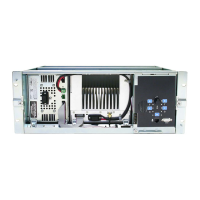86 Reciter Fault Finding TB8100 Service Manual
© Tait Electronics Limited September 2006
3.9 Exciter
These checks will verify whether:
■ the exciter synthesizer is locked
■ the exciter output meets the required specifications.
Task 1 —
Check Synthesizer
1. Set up the test equipment as shown in Figure 3.2 on page 73.
2. Run the Service Kit and connect to the reciter. Put the reciter in
Standby mode. Select Diagnose > Reciter > Synthesizers.
3. Check that the exciter synthesizer is locked. If it is, go to Task 2
. If
it is not, got to Step 4.
4. Click Start Test in the exciter row.
5. Check that the synthesizer lock range matches the frequencies
displayed in the Exciter setting box in the Monitor > Module
Details > Reciter form. If the two frequency ranges match, go to
Task 2
. If they do not match, adjust the exciter lock band using the
Calibration Kit and repeat this task.
Task 2 —
Check Exciter
Output
1. Put the reciter in Run Mode and set the TX KEY switch on the
CTU to ON.
2. Select Diagnose > Reciter > Digital I/O and check that the Tx Key
input is active (Service Kit “LED” is green). If it is active, go to
Step 3. If it is inactive (“LED” is red), return the complete reciter to
your nearest CSO for repair or replacement.
3. Use the Service Kit to set up the reciter as a repeater. Inject an RF
test signal (1kHz audio, 60% modulation) of the required frequency
at –80dBm (22.4µV):
■ narrow bandwidth 1.5kHz ±125Hz
■ mid bandwidth
1
2.4kHz ±200Hz
■ wide bandwidth 3kHz ±250Hz
4. Check that the performance of the exciter meets the following
specifications:
■ RF output power +11dBm ±2dB (8mW to 20mW)
■ deviation 60%
■ frequency accuracy ±0.5ppm or ±1ppm.
Note All reciters with hardware version 0.03 or later have a frequency
stability of 0.5ppm (VCTCXO). Reciters with hardware version
0.02 or earlier have a frequency stability of 1ppm (TCXO).
1. H band only.

